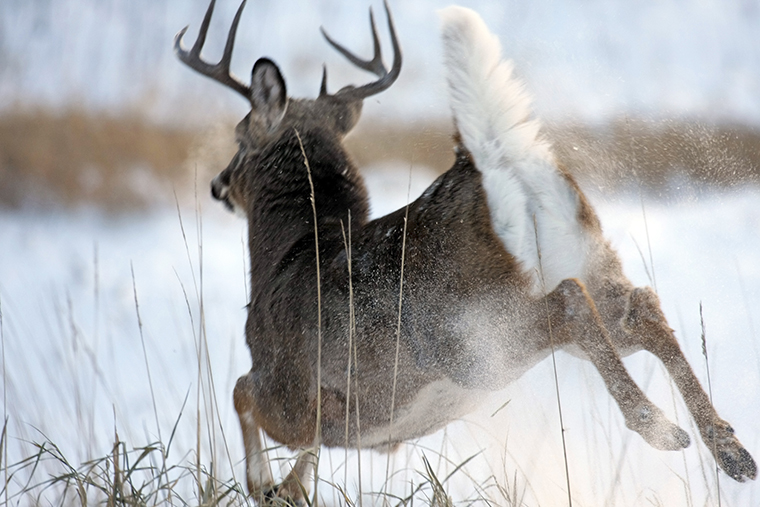
You’re left scratching your head when a blood trail peters out, or worse, doubting the shot because there’s no blood sign — we’ve all been there. But, when traditional tracking skills are combined with new blood-detection and tracking products, lost game can become a thing of the past.
A better track
Success after the shot begins before the shot. And knowing how animals react is an important part of that. Most alarmed or wounded animals will retreat along a safe path – typically, the one just travelled. So it’s important to watch their approach and commit it to memory. It could come in handy when unravelling a blood trail.
Sometimes, using game calls helps with tracking. From birth, animals are drawn to the contact call of their mother. As they grow, they respond to other vocalizations of their species as well. That’s why a contact call — the mew of a cow elk, or grunt of a deer, moose, or bear — can aid recovery, if sounded after the shot.
With a deer grunt, I have stopped deer, and on occasion, brought them back to drop within sight of my stand. Chances are good that calling will confuse, slow down, or possibly even stop the animal, thus reducing tracking distance. It also calms the animal, preventing the surge of adrenaline that is the enemy of tender meat.
Waiting key
Taking your time is critical. Impatience can turn simple tracking into a nightmare. It’s usually best to wait 30 minutes after the shot to begin tracking, but there are exceptions. The animal may be within sight and in the throes of death. In that case, another well-placed shot is prudent. Otherwise, the half-hour pause will serve to calm you down too and give you time to organize events in your mind.
Before you take to the trail, glass the kill zone for blood, hair, scuff marks, broken branches, or an arrow — anything that will point to the type of hit.
No matter how lethal the wound appears, take to the trail quietly. Just because you can’t see the animal doesn’t mean it can’t see you. If you pressure a wounded animal, it will continue to run. However, if you give it some time, it will bed as soon as possible and expire.
Don’t jump forward to the last sighting or sound, as valuable information can be missed. Blundering ahead and ignoring important signs can turn success into failure.

Hair clues
Knowing the length and colour of hair from various parts of your quarry is definitely helpful.
The impact zone (bullet or arrow) provides important initial clues. Is hair evident in the area? If so, what part of the animal did it come from? In the case of a white-tailed deer, dark or black hair is from the top of the animal, and white from the belly section. These don’t point to a fatal hit, but warrant further scrutiny. Shorter brindled, grey-brown-to-black hair is a welcome sight. This is found on the side of the deer.
Even a perfect hit may not produce visible blood for 30 to 60 yards. The ground may be hard with no obvious track. That’s why it’s important to recollect the position of the last sighting or sound. From there, scan in ever increasing circles until you pick-up blood sign.
After the shot, a hunter’s adrenaline and excitement can surge, causing the shakes. Breathe slowly and deeply. Calm your nerves, say a prayer, and savour the moment. If you track correctly, a hard-earned animal is waiting down the trail.
Got gas?
I find a low-tech gas lantern works better than a regular flashlight. The battery and bulb in a normal flashlight supply DC power, and deliver direct, steady light, whereas a gas operated lantern shines a flickering light that’s more effective at revealing blood droplets.
UV glow
Police and military professionals report that high intensity ultraviolet flashlights are critical tools in the detection of blood evidence. The ultraviolet light technology reveals blood not otherwise visible to the human eye. The blood actually absorbs light and doesn’t fluoresce — it’s the surroundings that glow and show the blood as black splotches.
According to a representative of CSI CRIME Sciences, a high intensity UV LED light in the 415nm wavelength will give the best results.
While I haven’t used these flashlights, there are a number online suppliers selling them. You might want to check hunting forums, crime supply stores and other sources before choosing a model.
Nine signs to watch for
During the initial stages of tracking, examining blood can confirm a good hit or ring the warning bell to back off for four to six hours. Here’s what the signs can tell you:
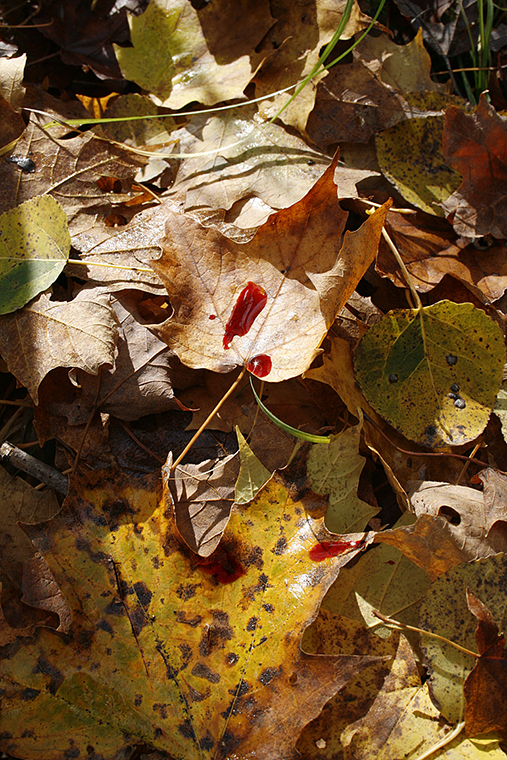
1. If there is no blood on the arrow, you’ve probably missed.
2. A broken arrow shows the depth of penetration but can also be cause for concern. Assuming the bow weight meets regulations for big game, you have likely hit bone and lost kinetic energy. Give it at least 4 hours before tracking. The broadhead is inside and hopefully damaging a vital organ.
3. Bright red or pinkish blood tells of a lung and possibly heart hit. Little blood sign for the first 40 or 50 yards could mean a high-lung hit. It takes time for the lungs to fill up and spurt blood out. Left alone, the animal will bed and should die within 30 minutes.
4. Dark blood on an arrow or on the ground indicates a stomach or liver hit. Green or brownish matter confirms it. Wait 4 to 6 hours – although fatal, the animal needs time to expire. Premature tracking can push an animal well beyond a hunter’s tracking skills. Even the smallest of Ontario big game, such as a panicked deer, can easily clock 20 miles an hour – so don’t push an animal that’s not ready.
5. A small speck may mean a slightly high, but fatal hit. Likewise, if an alert animal makes a fast, explosive exit, there might not be much initial blood sign. The fat layer and heavy coat on a bear can limit the amount expelled and the time it takes for blood to show, too.
6. A large splattering of blood or small specks at the initial site is cause for neither elation nor concern. A superficial neck or hind-end hit can offer immediate blood splatter.
7. A dragged leg is usually not a good sign. Back off and give the animal more time to bed. If it was a leg hit, another shot may be possible, but only after the animal has bedded and the leg has stiffened. It will be sluggish and reluctant to get up. But a leg hit could also be the result of a bullet or arrow passing down through vitals to break the leg on the opposite side.
8. The blood-speckled foliage along the animal’s flight path is often overlooked. Lung-hit animals spit and splutter blood from the mouth. It might be a spray located higher than your normal focus areas, but it’s there. A heavier splotch higher up on foliage can indicate a shoulder hit. Look for blood dripping down a leg and into the tracks.
9. If blood is visible on both sides of the trail, this probably means a complete pass through and easier tracking. In the case of a shot from a tree stand, air is sucked into the higher wound and blood forced out the lower one.
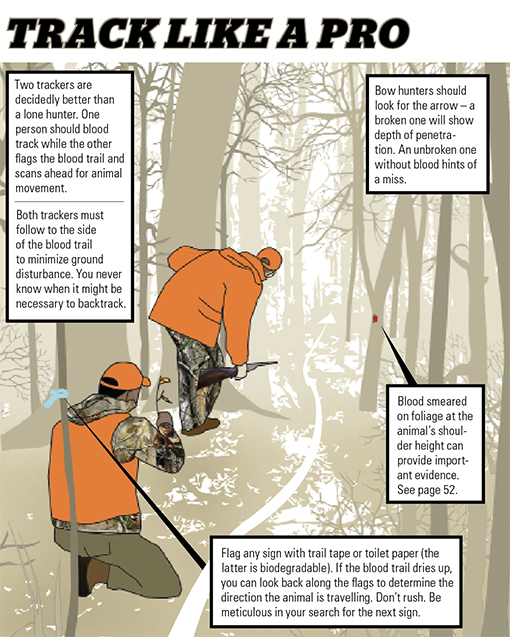
Originally published in the Nov.-Dec. 2013 issue of Ontario OUT of DOORS Magazine


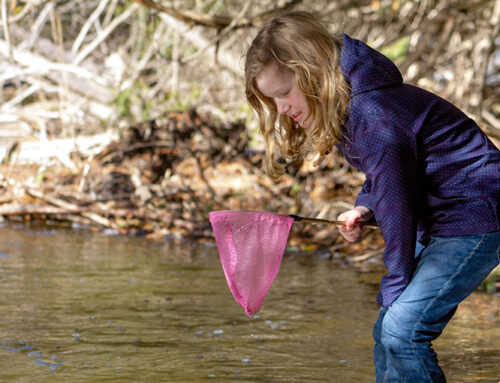

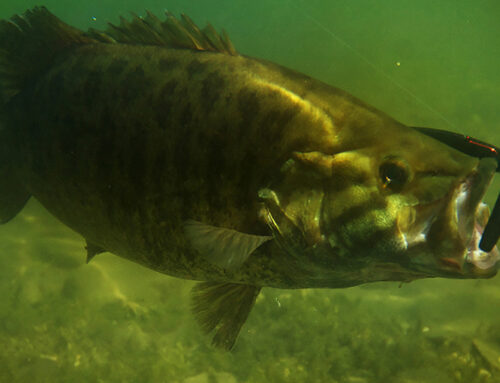
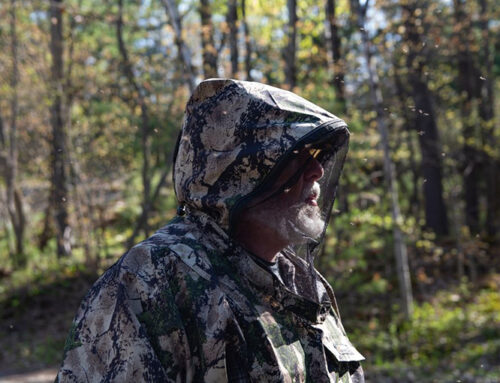
A great help in recovering game is the activity of ravens and magpies. Whiskey jacks come first, their excited Twitter and flitting around alert magpies, who come to investigate. Their activity alerts the ravens. Keep a sharp eye out for them. They are uncanny at finding wounded or dead game animals often within minutes after it drops or beds down. If an animal is lost after last light, be there at first light and scan the trees for birds. They can do a lot of damage in the backend if left alone with a dead animal.
Very important, check the activity of magpies, crows and ravens to alert you of the location of wounded or dead game!
I shot a doe this fall at 35 yds. She immediatly hit the ground, then 3-4 seconds later was back on her feet walking, quartering toward me. She stopped to look at me after about 10 yards, my scope on her, but no good shot to be had. She kept walking in the same direction, stopping to watch me again with no shot at about 15 yards from me. after a few seconds, she turned to walk away and gave me a broadside shot, which I took. I watched her disappear behind the rock ridge I was sitting on.
I waited a few seconds and heard what I thought was her falling to the ground somewhere in front of me. When my partner showed up, I explained what happened and we started looking as I lost the blood trail very quickly. We spent an hour and a half, searching in larger circles, with my heart sinking thinking I lost her completely. I told him we were going back to the spot she was standing when I shot. A pool of blood and a slight blood trail for about 10 yards and another pool, more blood trail and then a big patch of deer heair with blood, fat and bone fragments. I stayed there while my partner walked ahead and about 40 feet from there was my deer. She had gone slightly uphill and to the right of where I thought she went after the shot and laid down in a juniper bush. I had walked past her at least twice, because I believed in my head that she had gone farther.
Bottom line, don’t believe what you THINK happened after the shot, follow the trail of evidence.